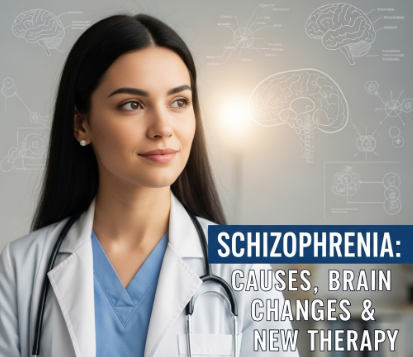
Schizophrenia: Pathophysiology and New Treatments
Overview
Schizophrenia is a complex, chronic mental health disorder characterized by distorted thinking, hallucinations, delusions, and impaired functioning. Affecting around 1% of the global population, it presents significant challenges in diagnosis and management. Recent advances in neuroscience have provided deeper insights into its pathophysiology and opened doors to novel treatments beyond conventional antipsychotics.
Pathophysiology of Schizophrenia
Schizophrenia involves disruptions in several brain systems and neurotransmitters, particularly:
1. Dopamine Hypothesis
The most widely accepted theory is the dopamine hypothesis, which suggests overactivity of dopamine D2 receptors in the mesolimbic pathway leads to positive symptoms (hallucinations, delusions). Conversely, underactivity in the mesocortical pathway contributes to negative symptoms (apathy, social withdrawal).
2. Glutamate Dysfunction
Abnormal glutamate transmission, particularly involving the NMDA receptor, is associated with cognitive deficits and negative symptoms. This has led to investigations into NMDA modulators as therapeutic targets.
3. Neurodevelopmental Abnormalities
Disruptions in early brain development, including cortical thinning, enlarged ventricles, and altered synaptic pruning, are observed in imaging studies of schizophrenia patients.
4. Inflammation and Immune Dysfunction
Elevated levels of inflammatory cytokines (like IL-6 and TNF-α) and altered microglial activity suggest that neuroinflammation may contribute to disease onset and progression.
Emerging Treatments for Schizophrenia
While traditional dopamine-blocking antipsychotics remain first-line, new therapies are being developed to address unmet needs, especially for negative and cognitive symptoms.
1. Second-Generation Antipsychotics (SGAs)
Drugs like cariprazine, lurasidone, and brexpiprazole offer improved efficacy for negative symptoms and have a better side effect profile than older drugs.
2. TAAR1 Agonists
Ulotaront (SEP-363856), a trace amine-associated receptor 1 (TAAR1) agonist, shows promise in treating both positive and negative symptoms without dopamine receptor blockade, thus avoiding extrapyramidal side effects.
3. Glutamatergic Modulators
Agents like bitopertin (a glycine reuptake inhibitor) and D-serine aim to restore NMDA receptor function and improve cognitive function.
4. Anti-inflammatory Therapies
Targeting immune dysregulation using NSAIDs, minocycline, or tocilizumab is under investigation as adjunctive therapy to reduce neuroinflammation.
5. Cognitive Enhancement Therapies
Research into drugs like encenicline (a nicotinic receptor agonist) and brain-derived neurotrophic factor (BDNF) modulators is ongoing to improve memory and executive functioning.
6. Long-Acting Injectable Antipsychotics (LAIs)
To improve treatment adherence, newer formulations such as paliperidone palmitate, aripiprazole lauroxil, and risperidone microspheres offer long-term symptom control.
Conclusion
Understanding the multifactorial pathophysiology of schizophrenia has paved the way for more targeted treatments. With continued research into neurotransmitter systems, neuroinflammation, and genetic factors, the future of schizophrenia treatment looks increasingly hopeful. Personalized medicine approaches may soon transform how we diagnose and manage this debilitating illness.
📚 Scientific References / Sources
- Howes OD, Kapur S. “The dopamine hypothesis of schizophrenia: version III—the final common pathway.” Schizophrenia Bulletin. 2009;35(3):549-562. https://doi.org/10.1093/schbul/sbp006
- Moghaddam B, Javitt D. “From revolution to evolution: the glutamate hypothesis of schizophrenia and its implications.” Neuropsychopharmacology. 2012;37(1):4-15. https://doi.org/10.1038/npp.2011.181
- Lieberman JA, et al. “Antipsychotic drug effects on brain morphology in first-episode psychosis.” Archives of General Psychiatry. 2005;62(4):361–370.
- Javitt DC, et al. “Glutamate and schizophrenia: phencyclidine, N-methyl-D-aspartate receptors, and dopamine–glutamate interactions.” International Review of Neurobiology. 2007;78:69–108.
- Koblan KS, et al. “A non–D2-receptor-binding drug for the treatment of schizophrenia.” New England Journal of Medicine. 2020;382:1497-1506. https://doi.org/10.1056/NEJMoa1911772
- Müller N. “Immunology of schizophrenia.” Neuroimmunomodulation. 2014;21(2-3):109–116. https://doi.org/10.1159/000356547
- Citrome L. “Long-acting injectable antipsychotics update: current use and future prospects.” Drugs. 2013;73(5):575–593.